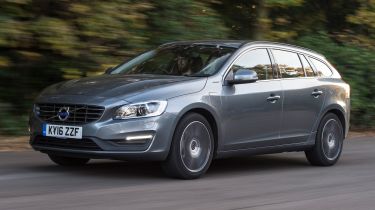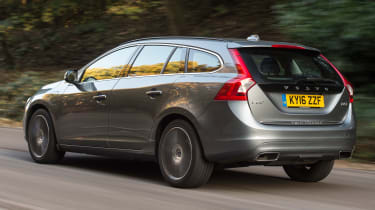Volvo V60 D5 Twin Engine estate 2016 review
Plug-in hybrid Volvo V60 is safe and comfortable but has limited appeal

Like most plug-in hybrids, the Volvo D5 Twin Engine will only appeal to a select group of buyers. You’ll need a short commute to run one, with the requirement for occasional longer trips - and the ability to ignore a dated interior will also be useful. Practicality suffers thanks to the batteries in the back, reducing boot space, and the added weight means it’s dull to drive too. The V60 D5 Twin Engine is comfortable, though, and has loads of safety kit.
The Volvo V60 D5 occupies a small niche in the UK, as while the standard V60 rivals models such as the Audi A4 Avant and Mercedes C-Class Estate, there’s not much that directly takes on this diesel plug-in hybrid.
The Mercedes C 350e is available as an estate and that’s probably the closest alternative to this Volvo as there aren’t many hybrid diesels around of any kind. Only the Peugeot 508 RXH comes close to the V60 D5 but that’s a conventional hybrid rather than a plug-in like the Volvo. Basically this V60 has a small niche all of its own, an odd combination of traditional diesel estate and modern plug-in.
Strange combinations are actually a running theme through much of the driving experience, as while the electric motor is advanced enough to run without assistance for up to 31 miles, the combustion engine itself is a rather old-fashioned five-cylinder unit.
The engine is not particularly bad, being much more pleasant than many modern four-cylinder diesels, but it needs more revs than these up-to-date powerplants to make good progress. Performance perks up when you really put your foot down though, as using help from the electric motor this V60 can go from 0-62mph in just 6.7 seconds.
Used - available now
We suspect that’s more down to the four-wheel drive grip rather than all-out power, however, as on the motorway the V60’s near two-tonne kerb weight means it feels more sluggish than the figures suggest. You certainly have to work hard to build momentum. At low speed the torquey power delivery from the electric motor is entertaining, though, with a sci-fi hum as you glide up to speed.
Bringing that mass down to a stop is one of the V60 D5’s most unpleasant aspects, as not only does it require more braking effort than a lighter equivalent car without hefty batteries in the back, the brake pedal itself has very little feel and is too imprecise.
Similarly, the steering has inconsistent weighting - feeling heavy around the centre and then lighter as you put more lock on. There’s plenty of grip in the corners but the strange steering and hefty kerb weight mean the V60 isn’t exactly fun to drive.
It is comfortable however, and Volvo has managed to fit supple enough suspension for good ride quality even with the weighty batteries under the boot floor. The seats are comfy too, and there’s little road and wind noise even at high speed so long journeys are nice and relaxed.
• Best low emissions green cars
The claimed combined fuel economy figure of 155.2mpg starts to look faintly ridiculous on longer runs, as while the 31-mile electric range will be useful for those with a short commute, the diesel is doing most of the work on the motorway, resulting in a real-world figure closer to 45mpg. It’s something most plug-in hybrids suffer from: they can make sense to some but for most people a conventional diesel will be cheaper to buy and cheaper to run.
You’ll be better served by a conventionally-engined V60 when it comes to practicality too, which many Volvo buyers will consider a key part of the car’s appeal. In the normal V60 you get a 430-litre boot with the seats up, and 1,241 with the seats down, but go for the D5 (or D6) plug-in hybrid and there’s only 305/1,126 litres in the back.
The interior is another place where you’ll spot the strange combination of old and new. While there’s plenty of up-to-date kit, including sat-nav, adaptive cruise control, auto high beams, DAB radio and auto-dimming mirrors, the cabin itself feels very dated.
The black plastics are good quality, but they aren’t up to the standard of those in rivals such as the Audi A4 and Mercedes C-Class, and it feels dark inside as well. The mess of buttons on the dash feel cheap to the touch, and even the chunky indicator stalks detract from the quality. It’s disappointing for a car costing close to £40,000 and although the Volvo is slightly cheaper than a C 350e, it feels much older.















